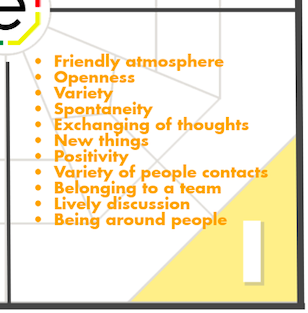Many of our teams are suddenly working remotely; creating new challenges for us, as managers.
 For the time being, many of us are experiencing a new normal. We may be working alone and away from our team members. We are taking on roles that may be brand new for us. As managers, this may be more challenging as to how to lead our employees virtually. We could all use tools which can help us better manage our remote workers and keep our teams productive. DISC can help us maintain effective communication and dynamics, even remotely, so we can continue focusing on our goals.
For the time being, many of us are experiencing a new normal. We may be working alone and away from our team members. We are taking on roles that may be brand new for us. As managers, this may be more challenging as to how to lead our employees virtually. We could all use tools which can help us better manage our remote workers and keep our teams productive. DISC can help us maintain effective communication and dynamics, even remotely, so we can continue focusing on our goals.
Your own leadership style, whether in person or as a remote leader, directly impacts how well your team performs. As managers, it is critical to stay aware of how you lead and knowing when to adjust your leadership style. One of our first critical tasks as managers is to lead our team through these many transitions.
Styles in transition
DISC reminds us to use our behavioral strengths, while at the same time, maximizing the strengths of our team members. As managers, we can ease the transitions by knowing how each of our employee tends to deal with change. There are some styles who will see it as an exciting challenge, while others may feel more apprehensive and look to you for support and direction.
This may not seem very different from a normal work setting, but your employees' styles may be more amplified under pressure. Under pressure, we don't have the same focus and energy to modify our style. So, we tend to fall back on our most natural way of doing things and can end up overusing our style.
The key is, to treat styles the way they prefer to be treated. In doing so, they will feel more comfortable with some of the transitions going on.
Motivating your D-style team members
 DISC can also help you and your team find more motivating ways of working remotely, while at the same time, avoid situations which may diminish their productivity. Your D-style prefer their independence and want to be in control when getting things done. They may feel more motivated if there is a sense of competition or challenge. If virtual team meetings are required, they will feel motivated if it helps them get their own tasks done. However, they may feel frustrated by chit chat or if the pace is too slow. In communicating with your D-style, make your instructions brief and measurable; tell them what they need to know and let them do it.
DISC can also help you and your team find more motivating ways of working remotely, while at the same time, avoid situations which may diminish their productivity. Your D-style prefer their independence and want to be in control when getting things done. They may feel more motivated if there is a sense of competition or challenge. If virtual team meetings are required, they will feel motivated if it helps them get their own tasks done. However, they may feel frustrated by chit chat or if the pace is too slow. In communicating with your D-style, make your instructions brief and measurable; tell them what they need to know and let them do it.
D-styles may forget to update you before moving on to their next task or project. They will look to you to be decisive and prefer quick check-ins.They may generate new ideas on their own because they are more comfortable taking risks and being big picture focused. However, guide them away from making too many mistakes because they may be moving too quickly or more focused on getting things done then doing it correctly.
Motivating your I-style team members
 Your I-Styles tend to feel more motivated if they have more variety and chances to interact, even if it's virtually. Remind yourself to that interacting with your I-styles virtually is important to keeping them motivated. Remember to give them opportunities to share their experiences and accomplishments. They may want to talk more about their day and feelings, rather than details and tasks, but these lively conversations can help keep them more productive.
Your I-Styles tend to feel more motivated if they have more variety and chances to interact, even if it's virtually. Remind yourself to that interacting with your I-styles virtually is important to keeping them motivated. Remember to give them opportunities to share their experiences and accomplishments. They may want to talk more about their day and feelings, rather than details and tasks, but these lively conversations can help keep them more productive.
They may be more excited with opportunities to try new things that are outside the normal routine. For example, have them set up an online group meeting for updates and check-ins. I-styles tend to be more frustrated by routine and structure so allow them more freedom to reach goals whenever possible. Try to keep your written communication focused more on the positives and less on details and facts.
Motivating your S-style team members
 Your S-Styles may need more reassurance and support from you during these times of chaos and change. They may feel more comfortable if there is a sense of continuity and long-term orientation. They need to know they can connect with you and their team members to gather opinions and be around familiar people. It's important for you to provide personal attention and sincere appreciation. The more they trust you and your team, the less anxiety the changes will cause.
Your S-Styles may need more reassurance and support from you during these times of chaos and change. They may feel more comfortable if there is a sense of continuity and long-term orientation. They need to know they can connect with you and their team members to gather opinions and be around familiar people. It's important for you to provide personal attention and sincere appreciation. The more they trust you and your team, the less anxiety the changes will cause.
Remember, answer their questions patiently and provide them with time to think and consider. Check in with your S-styles to see if they have any additional questions. They will work diligently once they understand what needs to be done.
Motivating your C-style team members
 Your C-Styles may feel more comfortable working on their own where they have the ability to focus on their work. However, they will want thorough instructions and information to get things done. So, help them get off to a strong start by providing them clear and logical direction. Once they understand the tasks, they will produce high-quality results.
Your C-Styles may feel more comfortable working on their own where they have the ability to focus on their work. However, they will want thorough instructions and information to get things done. So, help them get off to a strong start by providing them clear and logical direction. Once they understand the tasks, they will produce high-quality results.
As a manager, you can help your C-style create a new structured environment with organized duties. Remember, to maintain professionalism even though you may be working from home. Since many of our communication occurs by emails, make sure to pay attention to their questions and reply accordingly.
They may not be as vocal as others on your online group meetings; they are likely listening for understanding, just like your regular in-person meetings. Consider checking in after the meeting, to see if they have any input.
Final thoughts
Remember, you never want to make decision solely on your employee's DISC style. DISC focuses on behaviors; how your employees prefer to do things. Everyone is more than just their style; each team member has unique skills, experience, attitude, and knowledge that factor into their performance.
On a positive note, managing your team in the office and in each of your homes is fundamentally the same. You need maintain awareness of your style and your team members' styles; focus on their strengths and know what tends to motivate them. Then, you need to continue to adjust your style to interact more effectively. They will tend to respond better to your interactions and be more motivated to reach your team's goals. In these challenging and different times, we can give a little more to improving our interactions, and hopefully, our team will follow our lead. We know you are up for the challenge!
Please contact us if we can help: CustomerService@ExtendedDISC.org
